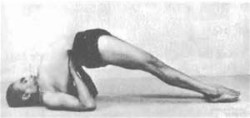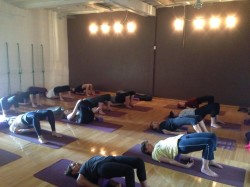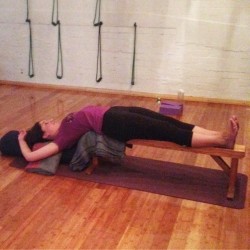Setu - bridge
Bandha – a body lock, bond, hold
Sarvangasana – shoulder stand
 You will likely have encountered this pose many times, and in yoga classes of all styles. Aside from ‘working your glutes’ do you understand the benefits and reasons why we incorporate Setu Bandha Sarvangasana or bridge pose into our practice so regularly? Here’s the lowdown…
You will likely have encountered this pose many times, and in yoga classes of all styles. Aside from ‘working your glutes’ do you understand the benefits and reasons why we incorporate Setu Bandha Sarvangasana or bridge pose into our practice so regularly? Here’s the lowdown…
First and most importantly, as the name suggests, this is a variation of shoulder stand (Salamba Sarvangasana) - which is also known as the ‘mother’ of all asanas. Check out our previous blog HERE for everything you need to know about shoulder stand.
In Light on Yoga (LOY p.213), BKS Iyengar says, “the importance of Sarvangasana cannot be over-emphasised…” and he lists many benefits including the increase of blood supply to the thyroid and parathyroid glands due to the chinlock, and to the heart due to the inverted nature of the pose.
In her book, Yoga a Gem for Women (YAGFW), Geeta Iyengar also says,”Asanas such as…Sarvangasana supply fresh blood to the brain and keep it alert, active and at the same time in a restful state.”
What’s the difference:
So what exactly is the difference between a regular shoulder stand and Setu Bandha Sarvangasana?
 While both require you to be supported on the very top of the shoulders, in the ‘bridge’ variation the body and legs are not stretched up towards the sky, but instead the feet are either pressing into the floor (pictured right) or the legs are straight, lengthening along the floor as seen in the traditional version (pictured above and in LOY).
While both require you to be supported on the very top of the shoulders, in the ‘bridge’ variation the body and legs are not stretched up towards the sky, but instead the feet are either pressing into the floor (pictured right) or the legs are straight, lengthening along the floor as seen in the traditional version (pictured above and in LOY).
Getting into the pose:
While many classes often get student into bridge pose from a laying down position, by simply pressing the feet and lifting the hips and buttocks up off the ground, it can be difficult to get onto the shoulders properly or stay in the pose for a long time - making it more of a good glute and quad workout.
In Iyengar yoga, we have many variations and a host of different ways to ensure we can get onto the shoulders and create that essential chin lock or ‘bandha’.
An active variation (as described in LOY) starts by doing a regular shoulder stand (full inversion) and then dropping the legs back to the floor behind you. Going in from this way really makes sure you can get and stay on the very top of the shoulders.
Props:
We use a range of props to help students get into and remain in the pose for longer than they could on their own, and to help deepen the pose too. (Believe it or not props can be used to make and asana harder, not just easier!)
Here are a couple of quick examples:


1. Home version: Using support (one or two blocks depending how tall you are) under the sacrum and resting the legs onto a couch, chair or any other support which is about the same height or slightly higher than your hips. In this version you want let yourself relax and soften so it becomes deeply relaxing, while opening the front body.
2. Studio version: On a yoga bench, with blankets under back (to soften and support) and a bolster or more blankets under the shoulders and neck. While this version is also fully supported, the height and angle of the bench means you get a much stronger arch in the back and a greater opening in chest. Students with lower back pain may not enjoy this one.
Menstruation & pregnancy:
While you can practice Salamba Sarvangasana and Setu Bandha Sarvangasana in the same class, Setu Bandha is used instead of shoulderstand at certain times – like during menstruation and pregnancy; when inversions are not recommended or possible. When done with lots of support, Setu Bandha Sarvangasana allows the belly and pelvic area to remain soft, while soothing the mind – essential qualities for these important times in a woman’s life.
A bit of a unicorn…
One of the things we love about this pose, is that it can literally be done on it’s own if you don’t have time for a full practice. It’s the perfect combination of energising backbend and restorative shoulder stand, and if you use support it can be restorative too!
There are many other options including the use of cross bolsters (literally two bolsters laid over one another in a cross). In YGM, Geeta also talks about closing or covering the eyes to help releive eye tension – a great suggestion for those of us who spend lots of time in front of computer screens every day.
Remember to always practice under the guidance of an experienced and certified Iyengar yoga teacher, let your teacher know of any injuries or health conditions and speak to your doctor or physiotherapist before starting any new exercise programs.
Send us your Setu Bandha Sarvangasana questions, tips and photos. Email info@yogatogo.com.au or message and tag us on Facebook, Instagram or Twitter.


